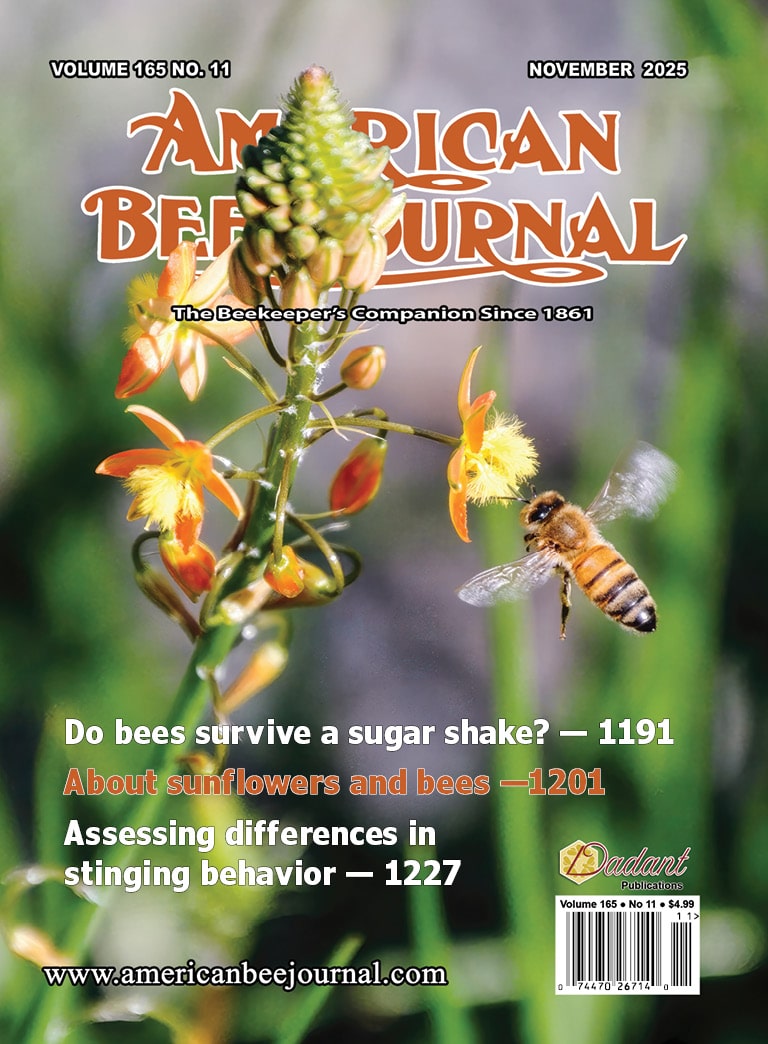The Curious Beekeeper
The Curious Beekeeper – February 2024 Baking with Honey: A Sweet but Sticky Saga

The unintended consequences of cooking with honey
During canning season about 15 years ago, I prepared an oversized batch of homemade barbecue sauce. The recipe called for a generous dollop of buckwheat honey, tomato sauce, vinegar, hot sauce, and a miscellany of spices and herbs.
An oppressive August heat filled the kitchen as I monitored the bubbling pot. All the while, my industrial-size range hood worked full tilt, drawing the luscious-smelling vapor through a long duct in the attic to a fan at the far side of the house.
As I prepared jars and lids and labels, I began noticing honey bees zipping around the trees in the front yard, dashing about like vultures at a road kill. For a while I watched through the windows, wondering what the bees had discovered so near the house and why they seemed manic about the roof.
When finally the kitchen work fell under control, I walked outside and circled the house, trying to solve the mystery. Then I saw it. High up, just below the roof peak, the outlet from the kitchen fan shone black with bees clasping onto the metal grid, struggling against the breeze that delivered the delectable aroma of buckwheat honey. That magnificent scent, unexpected during a summer dearth, lured bees like a magnet draws thumbtacks. Although they darted and dipped, circled and swerved, they never lost focus or strayed from their quarry until nightfall.
Baking with honey is a unique skill
Although many honey-lovers have good intentions, learning to cook with honey can be tricky, or even disappointing. Yet most of the time, it’s simple. Like my barbecue sauce, you toss in the ingredients and cook until done: When it tastes right, it is right. This includes marinades, sauces, dressings, candied nuts, ice cream, and many types of desserts. You add, mix, and taste until it suits you, and if you’re careful, you won’t draw bees from miles around.
Conversely, baking with honey is anything but simple. If you choose a recipe designed for honey, you should have no problem. In those recipes, the authors have calculated the vexing parts for you. They have considered the vagaries of acidity, sweetness, oven temperatures, and cook times in advance. Just follow the directions and presto — all the honey cakes, honey cookies, and honey buns you can eat.
However, the real challenge of baking with honey comes when you try to convert a favorite recipe, a tried-and-true winner, into one that replaces sugar with honey. Without careful calculation, a quick substitution can ruin a batch of your favorite bake.
Differences between honey and sugar
Most of today’s baking ingredients are reliably uniform. Sugar, flour, butter, and milk come with variations, but most brands won’t ruin a recipe. On the other hand, honey is anything but predictable, exhibiting large swings in texture, color, pH, and flavor. Let’s take a look at some of the differences and how each can affect your baked goods.
Honey is sweeter than sugar
Measure for measure, honey is sweeter than table sugar (sucrose). This is because fructose, a major component of honey, is the sweetest of all the natural carbohydrates, having nearly twice the sweetness of sucrose. Although glucose and sucrose have similar sweetness levels, the large amount of fructose makes honey (on average) about 1.5 times as sweet as table sugar.
However, sweetness levels are variable. Because the amount of fructose varies from one batch of honey to another, we can only rely on estimates of sweetness. If you want your recipe to be no sweeter than it already is, you can try substituting only part of the sugar with honey, maybe a quarter or a third. However, deciding how much to substitute is no simple task, and your decision may come down to personal preference.
Honey contains water
Honey is usually a liquid, whereas table sugar is a solid. That means you must estimate the amount of liquid in your honey and subtract that measure from some other liquid in your recipe. Many bakers estimate a measure of honey to be 80 percent sugar and 20 percent water. So if you wanted to replace exactly a cup of sugar in a recipe, you would need to add 1.25 cups of honey and subtract 0.25 cups of liquid (20 percent of the 1.25 cups) from other liquid ingredients.
How exact your measurements must be depends on your recipe. In an average home recipe, you rarely need to worry about these adjustments for amounts smaller than a half cup or so. But if you are using a large amount of honey in proportion to the dry ingredients, you may need to make adjustments. To avoid making your recipe too sweet, first decide on how much sugar you will replace with honey. Then, using that measurement, adjust for the liquid it will add.
Honey is acidic
We routinely bake with an assortment of ingredients that increase the acidity (lower the pH) of dough and batter. Common among these are vinegar, lemon juice, and other fruit and vegetable juices. In addition, things like buttermilk, coffee, chocolate, and brown sugar can acidify the mix. To counterbalance these acidic ingredients, we rely on baking soda.
The pH is important to the final product. In things like cake, acidity can enhance the flavor of other ingredients. Even more important, acidic ingredients can loosen the structure of both proteins and starches, which in moderation can assist with both leavening and tenderizing, but in excess, too much acidity can cause a total loss of structure. The pH affects even the appearance of baked goods because excess acidity can reduce browning, yielding pale, anemic-looking results.
Generations of bakers have developed recipes to perfectly adjust the pH. But the addition of honey tosses a monkey wrench into these best-laid plans. Depending on its source, honey can be very or only marginally acidic, ranging in pH from about 3.4 to 6.1. Very often, honey adds enough extra acidity that you need to compensate for it, if possible. However, since the components of honey are always variable, you may get different results from different batches.
Browning and the Maillard reaction
A complicated sequence of events in food chemistry called the Maillard reaction is partially responsible for the luscious taste and color of crusty bread, browned biscuits, and French fries.1 It also causes the deliciously charred flavor of grilled burgers, seared steaks, toasted marshmallows, and toffee, not to mention the rich flavor of dark coffee and dark chocolate.
The series of Maillard reactions occurs between two types of molecules — amino acids and reducing sugars — in the presence of high heat. A reducing sugar is a simple sugar such as glucose, fructose, maltose, and lactose, that can donate electrons to amino acids, causing those


